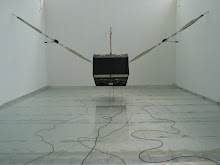Sol Lewitt's system
Sol Lewitt died today three years ago. I only encountered his work twice, first at New York's Andrea Rosen Gallery in 2003, again at the 2007 Venice Biennale. Both times they were wall drawings, the first a spare grid, the latter a paired set of wall drawings made up of whorls of lines that gained/lessened in tonal intensity. The austerity mesmerised.
The drawings in Venice were made around two months after Lewitt's death. The drawings exist and function independent of Lewitt's hand. In fact, there existence is prescribed, or rather, are predicated on a determined set of rules, the implications of which the artist discussed with Saul Ostrow in a 2003 issue of Bomb magazine:
SO: Once you start working serially, a certain amount of decision-making is being deferred. Say in the case of your wall drawings, which existed as a set of instructions. Giving the script over to someone else is adding another variable to the formula and has been interpreted as an attempt either to de-aestheticize the work or at least to distance the artist from the results so that it wouldn’t be about the artist’s taste. I once did one of your wall drawings myself. You sent me a set of instructions that read, “Using pencil, draw 1,000 random straight lines 10 inches long each day for 10 days, in a 10-by-10-foot square.” The distribution of the lines in the square was totally up to me. I didn’t know what you wanted it to look like.
SL: What it looked like wasn’t important. It didn’t matter what you did as long as the lines were distributed randomly throughout the area. In many of the wall pieces there is very little latitude for the draftsman or draftswoman to make changes, but it is evident anyway, visually, that different people make different works. I have done other pieces that give the draftsperson a great liberty in interpreting an action. In this way the appearance of the work is secondary to the idea of the work, which makes the idea of primary importance. The system is the work of art; the visual work of art is the proof of the system. The visual aspect can’t be understood without understanding the system. It isn’t what it looks like but what it is that is of basic importance.
Two things strike me a germane, as possibilities for future exploration:
1. By working serially a certain amount of decision-making is deferred. Is it, though, possible to translate this statement into imaginative fiction?
2. To what extent is it possible to systematise the process of writing fiction? Perhaps, as an option, a modular set of characters that migrate from story to story? Or, as an alternative, a plot that remains constant but is populated by new characters? Even in writing this I realise that these are merely experimental probabilities, not viable solutions in and of themselves.
Two things strike me a germane, as possibilities for future exploration:
1. By working serially a certain amount of decision-making is deferred. Is it, though, possible to translate this statement into imaginative fiction?
2. To what extent is it possible to systematise the process of writing fiction? Perhaps, as an option, a modular set of characters that migrate from story to story? Or, as an alternative, a plot that remains constant but is populated by new characters? Even in writing this I realise that these are merely experimental probabilities, not viable solutions in and of themselves.




0 Comments:
Post a Comment
Subscribe to Post Comments [Atom]
<< Home